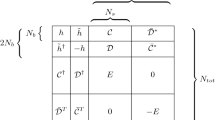Abstract
Size extensivity of the correlation energy is a crucial property of many-body methods (e.g., coupled cluster, Rayleigh–Schrödinger perturbation theory). It is related to the connectivity of the energy expression which itself relies on the connectivity of the amplitude tensors. Before the introduction of the concept of “generalized extensivity” by Nooijen et al. (Mol Phys 103:2277, 2005) there was no operational test to check for extensivity. The latter probes for connectivity of the energy by testing for separability using an artificial manipulation of the two-electron integrals according to varying partitionings of the orbitals. The present work tests for external connectivity of the wave operator and does not require specially crafted two-electron integrals but access to the values of the individual amplitudes and Coulomb integrals. External connectivity refers to the R-scaling of tensor entries with respect to the distance between the centers of the localized orbital indices. In contrast to “generalized extensivity” the present test does not detect disconnected closed diagrams within a tensor. Since standard coupled cluster tensors are always connected a diagrammatic analysis focuses on tensors related to various configuration interaction methods. In this respect the present work is complementary to that of Lyakh and Bartlett (Mol Phys 112:213, 2014) using algebraic techniques. The theoretical results are confirmed by the proposed operational external connectivity check. The proposed ansatz gives some insight into the property of connectivity especially the meaning of cluster lines and may be easily applied to other, particularly multi-reference coupled cluster, methods to check numerically for proper external connectivity of the amplitudes.


Similar content being viewed by others
References
Brueckner KA (1955) Phys Rev 100:36
Goldstone J (1956) Proc R Soc A 239:267
Hubbard J (1957) Proc R Soc A 240:539
Bartlett RJ (1981) Ann Rev Phys Chem 32:359
Coester F (1958) Nucl Phys 7:421
Coester F, Kümmel H (1960) Nucl Phys 17:477
Cizek J (1966) J Chem Phys 45:4256
Cizek J (1969) Adv Chem Phys 14:35
Cizek J, Paldus J (1971) Int J Quantum Chem 5:359
Bartlett RJ, Purvis GD (1978) Int J Quantum Chem 14:561
Pople JA, Krishnan R, Schlegel HB, Binkley JS (1978) Int J Quantum Chem 14:545
Nooijen M, Bartlett RJ (1997) Int J Quantum Chem 63:601
Hirata S (2011) Theor Chem Acc 129:727
Lyakh DI (2012) Mol Phys 110:1469
Lyakh DI, Bartlett RJ (2014) Mol Phys 112:213
Nooijen M, Shamasundar KR, Mukherjee D (2005) Mol Phys 103:2277
Hanrath M (2009) Chem Phys 356:31
Shavitt I, Bartlett R J (2009) Many-body methods in chemistry and physics, 1st edn. Cambridge University Press, Cambridge
Crawford TD, Schaefer HF III (2000) Rev Comput Chem 14:33
Bomble YJ, Stanton JF, Kallay M, Gauss J (2005) J Chem Phys 123:54101
Brandow BH (1967) Rev Mod Phys 39:771
Hanrath M (2018a) On the nature of connectivity: II. N-scaling of tensors and diagrams for coulomb interactions. Mol Phys (submitted)
Harris F E, Monkhorst H J, Freeman D L (1992) Algebraic and diagrammatic methods in many-Fermion theory, 1st edn. Oxford University Press, Oxford
Hanrath M (2018b) On the nature of connectivity: I. R-scaling of tensors and diagrams for coulomb interactions. Mol Phys (submitted)
Roothaan C (1951) J Chem Phys 19:1445
Hetzer G, Pulay P, Werner H-J (1998) Chem Phys Lett 290:143
Schütz M, Werner H-J (2000) J Chem Phys 114:661
Jeziorski B, Monkhorst HJ (1981) Phys Rev A 24:1668
Hirata S, Podeszwa R, Tobita M, Bartlett RJ (2004) J Chem Phys 120:2581
Kertesz M (1982) Adv Quantum Chem 15:161
Cloizeaux J des (1964) Phys Rev A 135:685
Acknowledgements
The author would like to thank Michael Dolg for his continuous support. This paper is dedicated to his 60th birthday.
Author information
Authors and Affiliations
Corresponding author
Rights and permissions
About this article
Cite this article
Hanrath, M. A simple and operational test for external connectivity of tensors in many-body methods. Theor Chem Acc 137, 86 (2018). https://doi.org/10.1007/s00214-018-2265-5
Received:
Accepted:
Published:
DOI: https://doi.org/10.1007/s00214-018-2265-5




